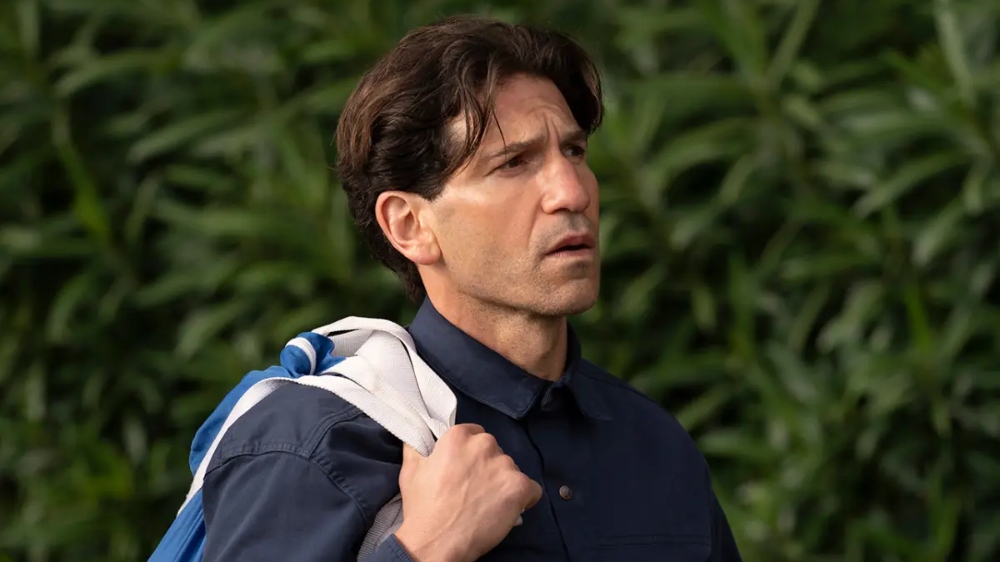
In 1980, the film American Gigolo made its debut in cinemas featuring a young actor named Richard Gere in the title role of Julian, a male escort who set wealthy women’s hearts aflutter. Four decades later, Showtime has reimagined the steamy story for the small screen as an eight-episode original starring Jon Bernthal.
The series finds Julian newly sprung from a 15-year stretch in prison after being wrongfully convicted of the murder of a client. Following his release, Detective Sunday (Rosie O’Donnell) is hot on his tail to find out the real truth. As Julian rifles through his past escort days and tries to rekindle a romance with his former love, Michelle Stratton (Gretchen Mol), a much bigger mystery begins to unfold.
The series’ Set Decorator Dorit Hurst (Thirteen, Red State) couldn’t resist the temptation to watch the original film, from which she took some initial inspiration that was further enhanced by the visual cues provided in the current storyline. A former page at Paramount, Hurst worked her way through the set dressing department, where she honed her design skills on various film and television sets such as The Mick and Speechless.
Coming full circle back to Paramount, whose television unit produces American Gigolo, Hurst worked closely with Production Designer Ray Yamagata to furnish the show’s sets, including a Venice Beach apartment that Julian moves into after prison, which is transformed from a hoarder’s delight into sexier, more stylish digs.
Below the Line spoke with Dorit Hurst via Zoom, which proved useful, as she was able to use the Share Screen function to bring up each image that illustrated her work. She discussed the many unique finds she found while rummaging through the estate sales of real-life hoarders in an effort to decorate Julian’s apartment. Hurst also revealed the story behind the ritzy Stratton mansion and discussed how the personal histories of the characters influenced the type of knick-knacks that inhabit their environments, and how each space takes on a personality of its own as a result of their backstories.
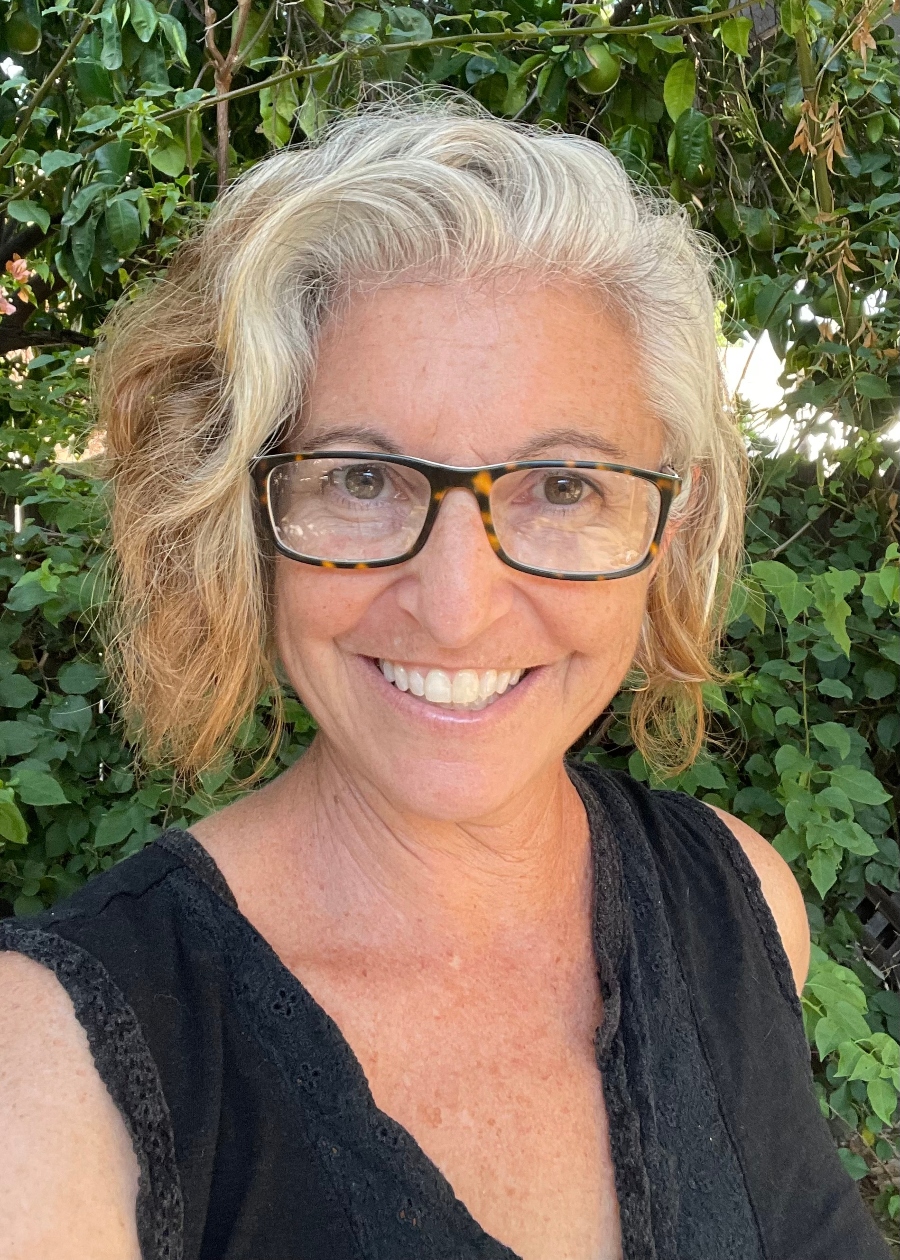
Below the Line: You began your career as a page at Paramount. How did you make the transition to set decoration?
Dorit Hurst: It’s kind of a long, circuitous route, as you can imagine. I graduated film school thinking I would be a director. Knowing that I probably wouldn’t get to do that right away, I also happened to be an art minor. Through college contacts, is probably how I got the page job, and through the pages [who] I met, I got to direct in a small theater group in Studio City.
What became evident was I didn’t really care about the actors. I was like, ‘Can you move out of the way so I can, like, set the scene?’ I was much more interested in creating a mood and a setting than I was anything else. So I just started, unbeknownst to me, being the art department on low-budget film projects. I was the prop master, the set decorator, [and] the on-set dresser. And then as you move through more and more projects, you learn [that] multiple people do these things. My focus just kind of honed into set decoration.
BTL: What were some of your biggest breaks?
Hurst: Being a studio page, it was like a temp service for the studio lot. At some point, I became a PA on Star Trek: Deep Space Nine, and then worked with the set decorator, [who’s] now retired, Laura Richarz. She hired me as an art department assistant. So I was kind of making my steps up. Then I had to get into the union, Local 44, which then kind of propels you into a real career. I then took my union card back to the people I knew at Paramount and said, ‘Hey, I’m a member now. You can hire me on your bigger shows.’ So I became a set dresser. On some TV shows, I worked with another decorator who’s a mentor, Amy Wells, so I have many mentors out there.
BTL: What was your big television break at Paramount?
Hurst: A show that has gone unseen called The Singles Table. At the time, it was my largest. I had three sound stages at Paramount. I now had an office and got to be the department head on a real show, which starred Alicia Silverstone. It was immense and lasted six episodes [before it] got the plug pulled on it. But the tours that came through got really good tours from me! If I had a moment to show them around the stage and explain things, I was big on that.
BTL: What were other television shows that you worked on to get your feet wet?
Hurst: I did The Mick. I did the second season of Speechless, and Single Parents over at Fox, and then through meeting those designers, it kind of parlayed into one-hour. So, slowly, [I made] the progression up to a Showtime one-hour, American Gigolo, and here we are.
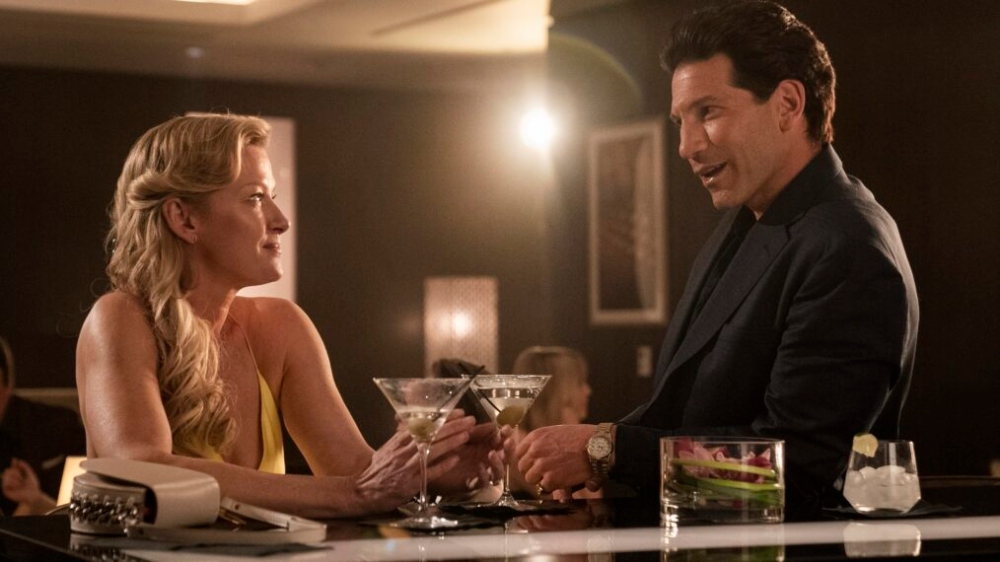
BTL: So coming full circle back to Paramount Television, how did American Gigolo come to you, and what was it about your background that made you a good fit for the show?
Hurst: I knew the art director, Ellen King, and she made the introduction to (production designer) Ray Yamagata. You know, different projects bring different characteristics. I think I’m known as somebody who likes to layer. I get really interested in the characters and showing a little bit more about the characters through the things that they have. So maybe that helped in this situation.
BTL: Did you go back to the original film for inspiration?
Hurst: Oh yeah. It was really clear and evident with the designer and [Director] David Hollander at the beginning, because we did do the pilot all together, and it was the same group that got to do the series, as far as the art department goes. We didn’t want to copy the ’80s, but certainly, it helps to have a place to draw references from. For myself, I was looking at particularly high-end art, and looking back at the ’80s art, but then who today was influenced by the ’80s, and then how are they interpreting it in more present day. So the ’80s film was just a point of reference. The real big reference was the use of window blinds, but that was less coming from me, but more, designer and DP and director kind of requests. That was a big theme in the film of having the kind of slats cutting up the body sort of stuff, in shadow. So we did do quite a bit of that in the show.
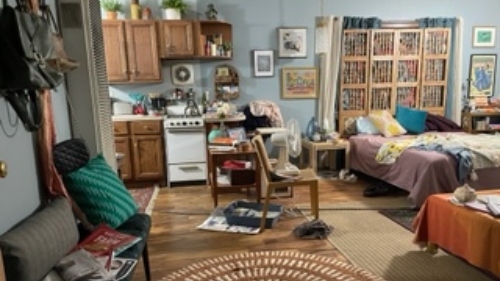
BTL: Talk about the inspiration for Julian’s apartment after he gets out of prison.
Hurst: That’s on a sound stage. The exterior was literally half a block up from the ocean This is actually in Venice Beach. So the exteriors are in Venice Beach. So, knowing we were going to be shooting a little bit inside, it was so small [that] it’s unfilmable. The apartments were so expensive, so we built it on [a] stage and it’s probably twice as deep as the actual location.
Sometimes in scripts, they don’t give you full-on descriptions of the space because it’s a character, you know. Before Julian’s there, it’s somebody else’s, so on occasion, it’s up to us to kind of fill that out. Who is it? Why were they here? Why did they leave things here? That’s a little bit of a conversation with the showrunner and the writers. And then they kind of help you come up with more backstory. We wanted to keep it connected to Julian’s character, who seems to be coming from his mother’s trailer, which was hoarded, and now he’s kind of finding himself living somewhere similar. He just can’t get away from his past.
BTL: In a way, you’re marrying the items to the character and what it means. Talk about some of the items and where you found them.
Hurst: Some of the things that we wanted to see as his items are underneath. The coffee table was a coffee table I thought was a super cool find that maybe Julian found or that suited his character, [and it] was kind of referential to the ’80s, kind of a vintage piece that maybe he found in a thrift store or something. But then we wanted to cover it so that it could be uncovered, so he could find it in the apartment.
It’s the same thing with the bed. We added the folding screen headboard to kind of mask the window a little bit and to bring more of an eclectic feel, [which] was found in a wonderful thrift store. A lot of these things were found in wonderful thrift stores in Long Beach — Urban Americana and Legacy Consignment. I can’t remember who came up with the idea [for] the litter box, but we decided that the character needed to have had a cat. Like, the previous tenant was a cat person.
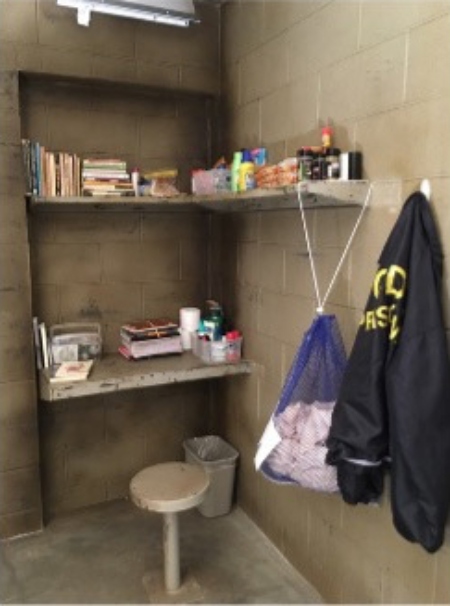
BTL: What would you say was your most precious find?
Hurst: Probably the hanging fixture, which I believe I found on Etsy. It’s kind of like a cut crystal from the early ’80s/late ’70s. The inspiration was [that] it started off as an opera singer’s apartment, so it kind of suited her, and then [it was] something Julian might keep as a shiny object that he would’ve still thought was a beautiful piece. I think he still appreciates beautiful things.
BTL: How did Jon Bernthal interact with these spaces?
Hurst: Jon Bernthal himself had his own ideas about his character — that he still likes beautiful things, but he wouldn’t necessarily go out and purchase super expensive things. It was more things that he could find or he found in the apartment, and he’s so good at pinpointing style that he’d be able to kind of shift things around. He grew up learning, like, multiple languages and multiple cultures and how to get along with the things that are put in front of him, to kind of develop his own character. I think he did a lot of character development in prison, so he still has this knowledge of fine art. So how can we kind of show that in a very cheap Venice apartment? So that [was] interesting.
BTL: Were there items that Jon said, ‘Nah, this doesn’t work?’
Hurst: He kind of wanted things to be balanced. We did it more, actually, in the pilot, in his prison cell. We weren’t sure how much he had accumulated, so I dressed his prison cell kind of full, as full as you could in a small space. And then he himself spent some time with the door closed, playing around in the space, and then kind of started pulling his own things away and would leave them at the door. Then I would come in and just kind of take them away.
In the bedroom, there are little callbacks to the prison — a shelf with books on Zen and meditation. We kind of did the same thing in the prison cell. He had a desk in the prison cell with some books and items, so we kind of wanted some repetitive themes throughout, or he took those home with him.
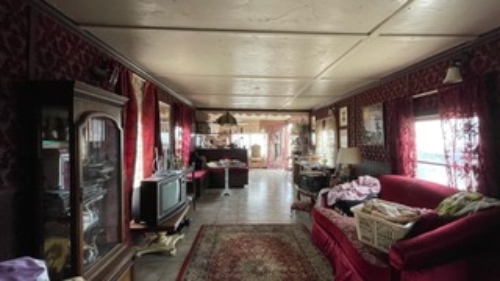
BTL: How would you describe the vibe of this variation of Julian’s apartment?
Hurst: It’s kind of Moulin Rouge, very romantic and out there. So there were a lot of textures and red, and then we kind of lightened the edges with the far front of the trailer, which was more of a pink [hue] in the bathroom. This is one of my favorite sets. It’s an actual trailer in Lancaster. This set was an actual apartment set up in a trailer, so the trailer had many different walls that the designer came through and took out because you couldn’t even fit a camera because it was so tight.
Because it was an old trailer, I think construction had to come through and, like, shore up the flooring and shore up the walls and the roof. Why we didn’t just build our own, I’m not sure, but there was talk of moving the trailer to the stage at some point. It was so old that it would just not even have made it. So they decided to just shoot it as is on site and it had a relationship to the trailer next to us, which we also owned and gutted and dressed.
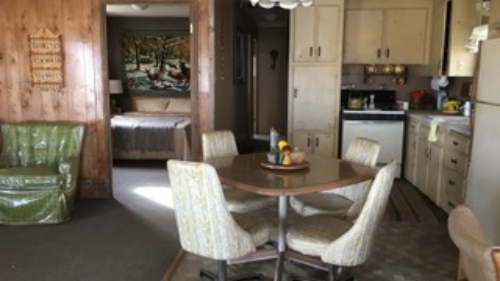
BTL: Was that trailer for the green-eyed woman, the landlord of the trailer park?
Hurst: That was the most fun. I didn’t know that much about her character, but I knew she was kind of gross and I knew what she was up to, so I didn’t like her very much. I found myself walking around the thrift stores going, ‘Oh, that’s gross, I’ll pick that for her.’ I kind of accumulated a bunch of “gross” items, things that weren’t that attractive or things that were kind of out of date, like that green chair in the back. That’s disgusting, especially with the plastic on it. I found that rug for, like, $3 in a thrift store. I made it into a wall hanging in the back bedroom, but it’s like animals being slaughtered. It’s kind of really great once you put the things in it and try out different pieces and it kind of comes together that way.
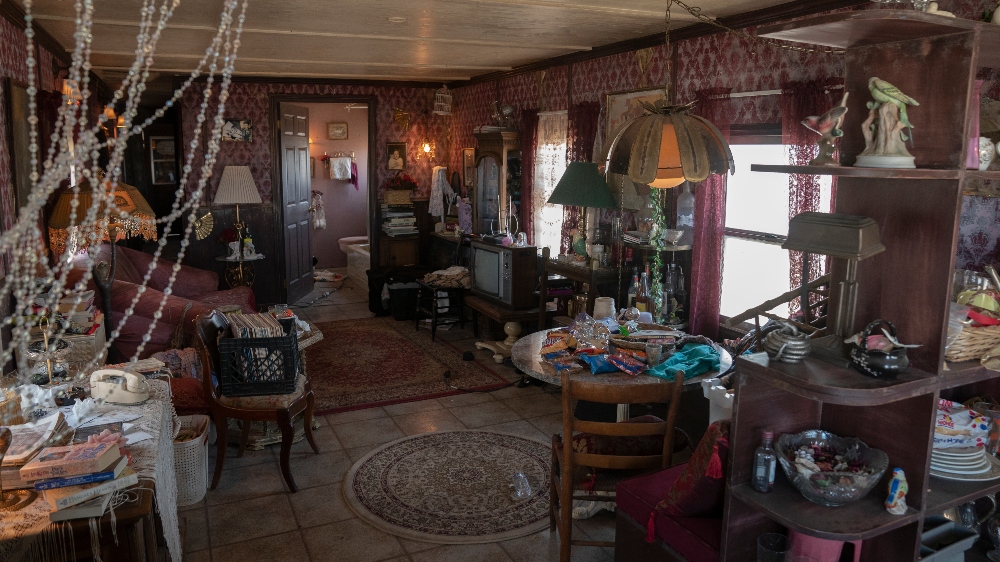
BTL: This one I love. This is a hoarder’s delight.
Hurst: That was fun. This is after Julian gets out of prison and goes right back to the trailer park to visit with his mother and finds it in this hoard state. If you watch any of the hoarders shows, they kind of come to a stopping point of growth and just because they’ve lost so much emotionally, maybe a family member, they just kind of hold on to everything physically because they can’t kind of overcome that emotional state. This was kind of fun to see what we could fit in there and still make it filmable. There’s a very specific path that we had to secure all of those things because you have a camera crew and actors moving through and you didn’t want everything falling over every time somebody walked through!
BTL: I understand you found many furnishings at actual hoarders’ estate sales.
Hurst: So there’s just general estate sales and I spoke to one of the women who runs estate sales asking about them. Oh, it was that weekend. After the estate sale itself, I was walking into the house, there were definitely chunks of already pulled-out furniture that had been purchased or whatnot. But people literally pulled things out of drawers and just dumped them on the floor. So we brought in our own boxes and just kind of made a big pile in the living room and then we just filled boxes and totes. Whether it was piles of clothes or things that you find in a junk drawer; it takes quite a bit of effort to fill a junk drawer. Some of my favorites were a shoebox that had multiple tools, sewing, old mail, string, you know, just those things that are difficult to come by in this small minutiae of it. A coffee can that had old pens and pencils. So there are some of those pieces throughout this trailer Those kinds of things are just a delight to be able to find anywhere.
BTL: It must be very frustrating when some of the things don’t find their way on camera.
Hurst: Yes, decorators have to meditate a lot. [laughs] I learned from another mentor, (production designer) Greg Melton, who said that we kind of create the playgrounds for the actors, and it kind of helps inform the character. It goes back to creating an environment and a feeling and a mood. When you walk into this space, you wanna create that. That kind of helps propel the acting and you hope to assist in that. So yeah, the little vintage can with the old pencils might not be seen on camera, but I know it’s there and throughout their scene, [they] might notice it’s there and it might make them more in touch with where they are.
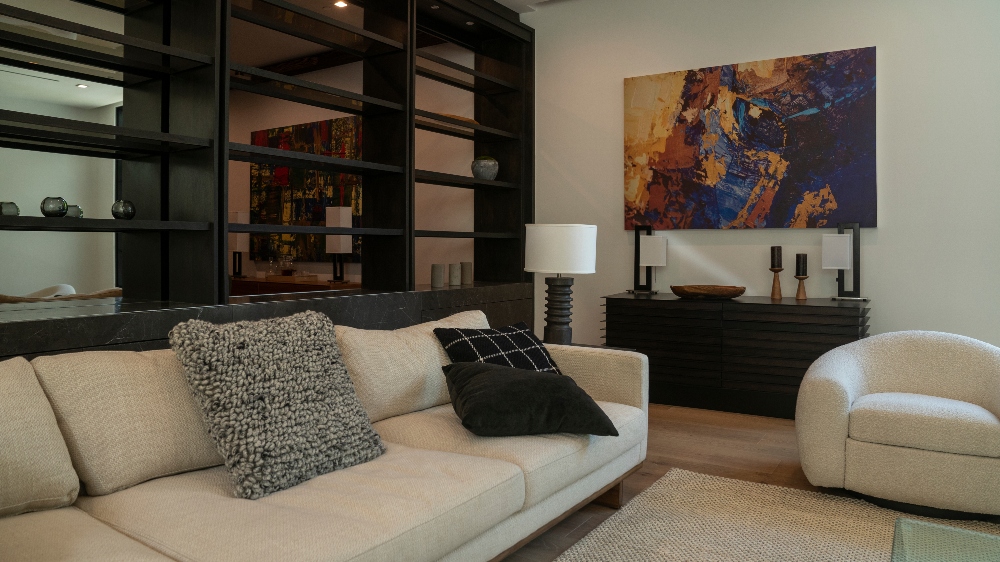
BTL: Describe how you designed this mansion through character.
Hurst: This is the Stratton house. We are not just in hoarded spaces, but also in really huge, beautiful mansions, and sometimes in those big, huge spaces, you still create some form of a character connection. It’s a bit trickier. I want to help tell the story of the character, but sometimes these mansions or people of great wealth [who] are shown in kind of a negative light are a little soulless. It’s all kind of surface-y and you don’t get to go really deep. It was a mansion that was on the market, so we went there every week, but every time we filmed we had to strike our things if they had a viewing. Some of the art was purchased or rented, [and] some of the art I manufactured using images from iStock and then printed them on canvas and [got] them framed.
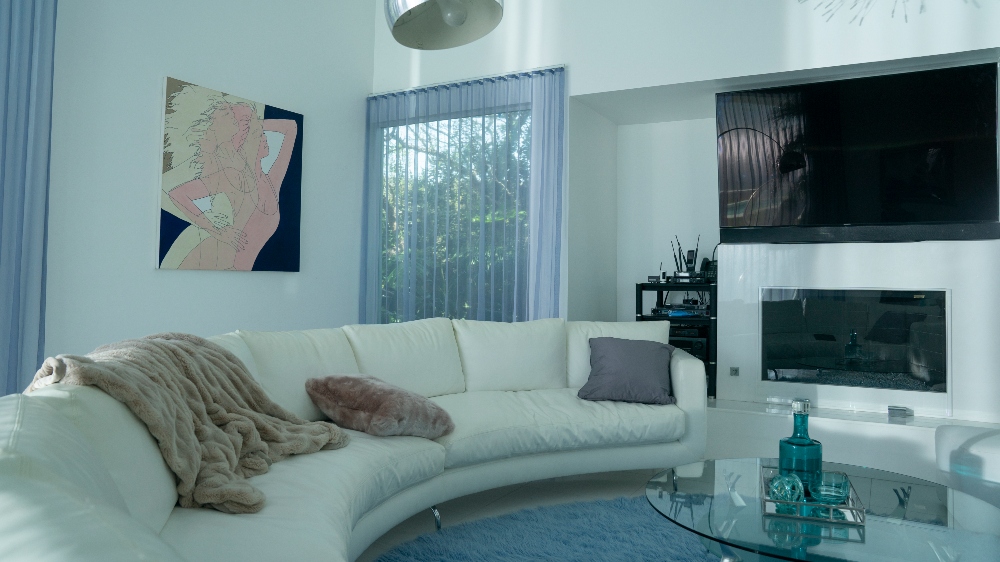
BTL: This set is almost art deco compared to the others.
Hurst: We called it the blue house. It’s a house right off [the] Pacific Coast Highway. It was all white and lavender and had, like, a blue tint to it, so we didn’t really stray from that color palette because if you brought any other color in it was, like, weird and odd. This was, like, the party pad. This is where all of the gigolo-ing happened. The artwork is a piece by Hilary Bond and she definitely is referential to the ’80s. They didn’t have such big screens back then but we weren’t allowed to touch that wall. In the show itself, you don’t really see this direction very much. It was really a living house and another huge mansion that we kind of came and went from each week. There was a piano we had to use. We couldn’t move the couch. We did take it out one time, but they were not happy. This set is basically someone’s home, as is.
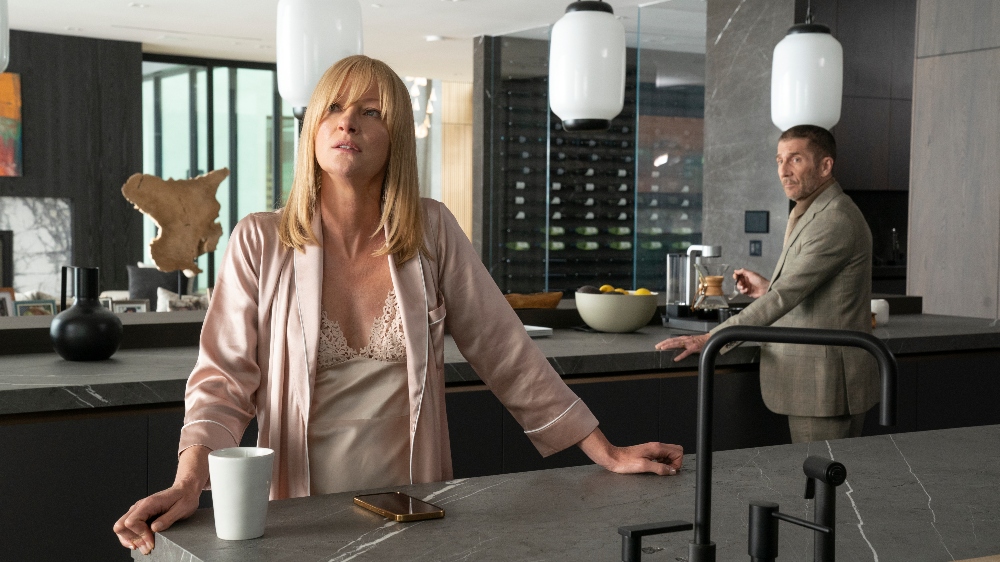
BTL: What did you want the kitchen to reflect?
Hurst: This is a house that had a lot of light fixtures and things, but it was really beautiful — lots of beautiful stone, wood, and natural, muted tones. I worked really delightfully with the Costumer, Stephani Lewis. She was putting the character of Michelle (Gretchen Mol) into a lot of neutrals.
We could tell a little bit more by, just like in the corner to the left, as a piece of art that had a bit of orangey-red to it and a little bit of orangey-red in the fruit on the countertop. And that was kind of all the color that we brought in.
BTL: So in the end, what would you say is most rewarding about your job?
Hurst: When I read the script and I have my own image in my head about what it might look like and then opening up for the company if I get to do all of the little details that I’ve kind of thought up during prep. It’s when I have an image in my head and I’m able to translate it to the designer and to a director, to my set dressing crew, who are phenomenal, [and] to get all my buyers to go find the things that I have in my head. If it all can show up, and then it turns out and it creates that mood that I had in my initial read of the script… I think when all those boxes get checked, it feels satisfying.
The Season 1 finale of American Gigolo will premiere this coming Sunday night on Showtime.





